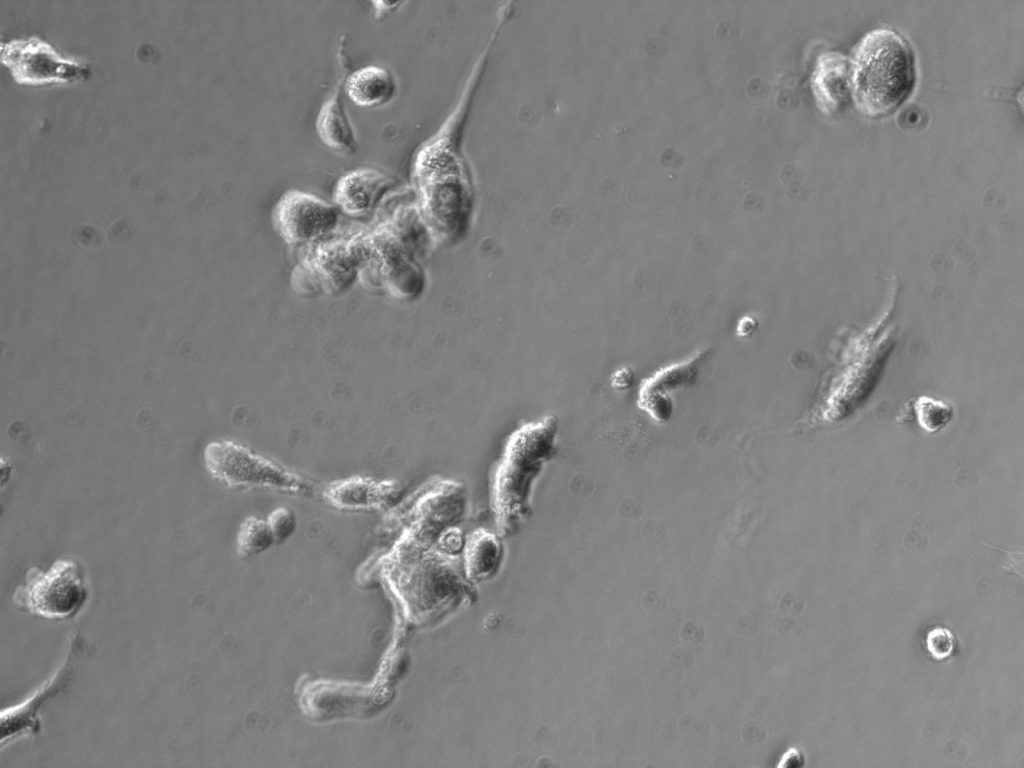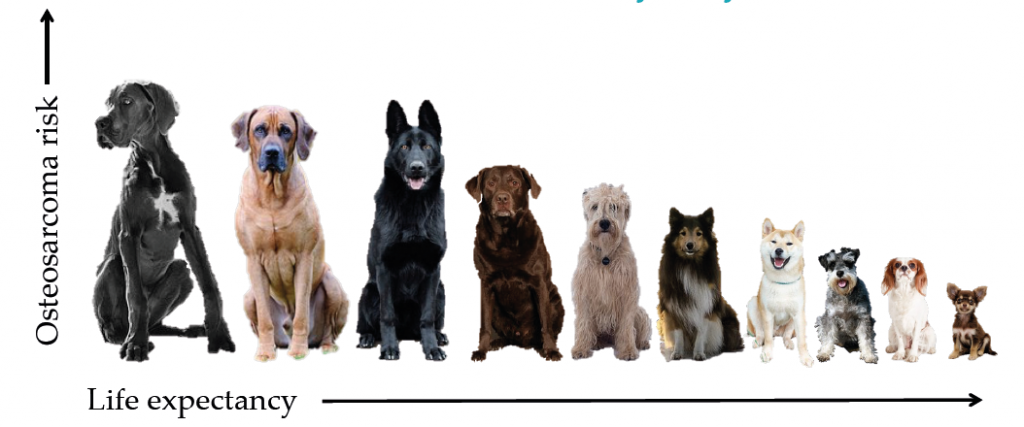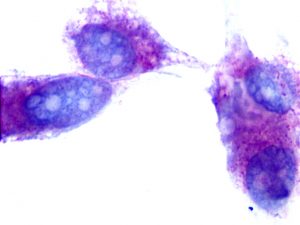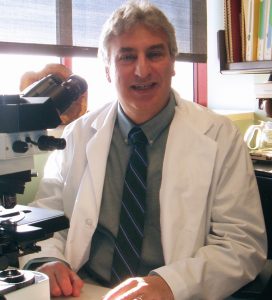Dr Jaime Modiano – Understanding Cancer Development in Humans and Their Companion Animals
Dogs are renowned for their status as man’s best friend. Based first at the University of Colorado and now at the University of Minnesota in the Twin Cities, Dr Jaime Modiano and his team have spent the last 25 years trying to understand how cancer develops at a basic level, aiming to use this knowledge to improve the health and wellbeing of both humans and their companion animals.
Dogs as Models for Cancer Research
Throughout human history, dogs have helped us to hunt and care for our livestock. Not only are dogs widely accepted as being the first domesticated animals but they also quickly became our most favoured companions. Today, many dog breeds are the result of breeding for desirable characteristics, such as a particular colouring or size, in addition to their historical roles of hunting, herding, and protection. As a result, many breeds have been developed under intense artificial selection, often drawing from a small pool animals.
Dog breeders are starting to recognise problems with this approach: while the process has produced specific breeds with particular characteristics, it has also led to serious health concerns, such as increased susceptibility to many genetic diseases and possibly certain cancers. Curiously, some types of cancer seem to be more prevalent in a few breeds.
Dr Jaime Modiano and his team at the University of Minnesota in the Twin Cities, USA, focus on trying to decipher the mechanisms associated with cancer development by comparing several malignant diseases in humans, dogs, and laboratory animals. ‘Recognising that the full spectrum of malignancies seen in humans also occurs in dogs sets an ideal stage for dual-purpose research that can accelerate progress against these diseases in both species,’ explains Dr Modiano.
Findings from Dr Modiano and his team converge with those from other researchers to suggest that it is now time to take things a step further by looking at dogs to identify new and perhaps better ways to treat humans. ‘We are faced with a unique opportunity to advance our understanding of similar diseases in unrelated species, and specifically those that might have a link to the evolutionary origin of these species, by using comparative genomics,’ proposes Dr Modiano. ‘The answers we obtain by studying cancers in dogs will contribute to our ultimate goal of designing strategies to prevent and treat cancer in both dogs and people.’
‘Our original premise was that there would be highly conserved or even identical genetic factors that could cause cancer in humans and dogs, but we later found that this was only rarely the case.’

Cancer cells in culture – phase contrast image, credit Jaime Modiano
Similarities in Dog and Human Cancers
At first, dogs seemed to provide the perfect model by which to study human cancer for Dr Modiano and his team. As animals that share our homes, dogs make it possible for us to examine the intrinsic risk factors for the development of cancer within two species sharing a common environment. In addition, dogs have shorter life spans, and, as up to four or five generations can exist at the same time, they provide unique opportunities to address critical questions about the origins and behaviours of cancer. ‘Our original premise was that there would be highly conserved or even identical genetic factors that could cause cancer in humans and dogs, but we later found that this was only rarely the case,’ notes Dr Modiano.
One of their initial approaches, conducted in close collaboration with Dr Matthew Breen at North Carolina State University in Raleigh, USA, involved looking at certain regions in the canine genome that were related to regions in the human genome and which, when scrambled from their original order and rearranged to come together into new, abnormal conformations, are known to cause lymphoma and leukaemia (blood cancers) in humans and mice.
Drs Breen and Modiano identified peculiar similarities in certain lymphomas and leukaemia between dogs and humans. These findings led them to suggest that some cancer risk might trace back to primordial similarities that preceded the evolutionary separation of both species. However, it also was possible that risk was attributable to random errors in the process of cell division. In this case, cancer would happen because the alteration in the order of critical genes would provide cells a strong survival advantage over its neighbours, setting the stage for more and faster cell divisions, additional mutations, and eventually, uncontrolled proliferation and cancer. Either of these mechanisms could explain the mutations shared between certain types of cancer in dogs and humans.
‘The data suggested that heritable causes were not the singular explanation for the similarities and differences in the cancers observed among different breeds of dog.’

Risk of osteosarcoma and life expectancy are associated with body size in dogs. Large and giant breed dogs generally have shorter lifespans and an increased risk of osteosarcoma compared with smaller breed dogs. Credit Kelly Makielski and Aaron Sarver
An Unexpected Twist
The trend for finding similarities between dog and human cancers was growing stronger with every study, until early 2011, when Dr Modiano and his colleagues happened upon some unexpected results. The original plan was to categorise dog lymphomas using the same parameters used for human cancers. The research team identified three groups based on prognosis, ranging from slow progression, typically treated with low-intensity chemotherapy, to aggressive and rapidly progressing tumours with a poor response to treatment.
However, some odd results emerged in this work that did not match the patterns of gene expression characteristic of human lymphomas. ‘Despite other groups publishing data that they interpreted as supportive, our own data did not agree,’ emphasises Dr Modiano. The exact reasons to explain this disparity were difficult to pinpoint. One explanation could be the large natural variability in this type of cancer, or perhaps the canine version refers to a single subtype of the cancers found in humans, therefore masking the distinction between subtypes. Another explanation could be that dog and human variants of the cancer are convergent forms of similar diseases; that is, being of different cellular origin but having other shared features.

Cancer cells in culture – protein stain image, credit Jaime Modiano
Findings arising from Dr Modiano’s long-standing collaboration with Dr Kerstin Lindblad-Toh (at the Broad Institute of the Massachusetts Institute of Technology and Harvard University in Cambridge, USA), and with Dr Breen, posed further critical questions. The researchers observed mutations in three breeds with a high risk of developing lymphomas – boxers, cocker spaniels, and golden retrievers. As Dr Modiano explains, ‘The data suggested that heritable causes were not the singular explanation for the similarities and differences in the cancers observed among different breeds of dog.’ Moreover, with very few exceptions, the recurrent mutations found in canine lymphomas did not match mutations present in human cases of the same cancer.
Dr Modiano elaborates that, ‘We now know that a major similarity between dogs and humans is that they have both broken the evolutionary constraint on longevity – or life-expectancy – and so the risk of cancer that is attributable to chance (which accounts for the vast majority of tumours) is comparable.’ Simply stated, people and dogs are living longer, so both are at greater risk of getting tumours. In both species, mutations are introduced during the normal processes of DNA replication and DNA repair, but the actual mutations that provide a selective advantage for the tumours to grow are quite different.
‘We have underestimated the significant role evolution has played in selecting for cancer-protective mechanisms across the animal kingdom.’

A Different Perspective
On the basis of this work, Dr Modiano and his colleagues arrived at a critical, new perspective. ‘Looking at the data more broadly allowed us to become a bit more realistic about the role of the dog as a model,’ explains Dr Modiano, ‘and we started seeing cancer in both humans and dogs as the consequence of events associated with longevity.’
By leading to higher levels of cell division, more DNA damage, and a higher probability to accrue the mutations that result in cancer, the longevity that we may justifiably consider a blessing comes at a cost, according to Dr Modiano. Animals that have a naturally long life, such as elephants, whales, and mole rats, for example, have developed ways to protect themselves against cancer. Humans and their pets, however, have expanded their evolutionary life spans several-fold in only a relatively short space of time. This may well explain the higher rates of cancer as we get older, as such a rapid increase in relative longevity is uncommon in the animal kingdom. For cats and dogs, the usual process of slow natural selection has been replaced by an accelerated artificial selection.
The problem with this artificial selection is that it does not allow natural processes to select for animals adapted to the new longevity. Natural selection is driven by interactions with the whole social structure of the species and the environment, and this has happened for every species independently. Our dogs and cats evolved to live to about four and eight years old, respectively, but now live to around 10 and 20 years old.
‘We have underestimated the significant role evolution has played in selecting for cancer-protective mechanisms across the animal kingdom,’ concludes Dr Modiano, ‘and we have significantly under-appreciated the importance of how our success in outliving our evolutionarily determined lifespan has greatly influenced the risk for cancer in our species.’ Nevertheless, in a positive vein, Dr Modiano proposes that the scientific community should not see cancer as inevitable but should now focus on developing ways to delay or even prevent its development both in humans and in our companion animals.
Reference
https://doi.org/10.33548/SCIENTIA425
Meet the researchers

Dr Jaime Modiano
College of Veterinary Medicine and Masonic Cancer Center
University of Minnesota – Twin Cities
Minneapolis, MN
USA
Dr Jaime Modiano completed both clinical veterinary training and a PhD in Immunology at the University of Pennsylvania, followed by a residency in Veterinary Clinical Pathology at Colorado State University and a post-doctoral fellowship at the National Jewish Center for Immunology and Respiratory Medicine. After a brief period at the Texas A&M College of Veterinary Medicine and eight years at the AMC Cancer Research Center and the University of Colorado Health Sciences Center, Dr Modiano joined the University of Minnesota in 2007. He currently holds the prestigious Alvin and June Perlman Endowed Chair of Animal Oncology and is the Director of the Animal Cancer Care and Research Program of the College of Veterinary Medicine and the Masonic Cancer Center at the University of Minnesota.
CONTACT
KEY COLLABORATORS
Dr Aaron Sarver, University of Minnesota (USA)
Dr Kerstin Lindblad-Toh, Broad Institute of MIT and Harvard (USA) and Uppsala University (Sweden)
Dr Matthew Breen, North Carolina State University (USA)
FUNDING
National Cancer Institute/National Institutes of Health (USA)
United States Army Medical Research and Materiel Command/Peer Reviewed Cancer Research Program
Morris Animal Foundation
AKC Canine Health Foundation
The Zach Sobiech Fund of the Children’s Cancer Research Fund
Animal Cancer Care and Research Program, University of Minnesota
The V Foundation for Cancer Research
FURTHER READING
K Megquier, J Turner-Maier, R Swofford, et al, Comparative genomics reveals shared mutational landscape in canine hemangiosarcoma and human angiosarcoma, Molecular Cancer Research, 2019 doi: 10.1158/1541-7786.MCR-19-0221.
KM Makielski, LJ Mills, AL Sarver, et al, Risk factors for development of canine and human osteosarcoma: A comparative review, Veterinary Sciences, 2019, 6, E48.
MC Scott, NA Temiz, AE Sarver, et al, Comparative transcriptome analysis quantifies immune cell transcript levels, metastatic progression, and survival in osteosarcoma, Cancer Research, 2018, 78, 326–337.
I Elvers, J Turner-Maier, R Swofford, et al, Exome sequencing of lymphomas from three dog breeds reveals somatic mutation patterns reflecting genetic background, Genome Research, 2015, 25, 1634–45.
D Ito, AM Frantz, JF Modiano, Canine lymphoma as a comparative model for human non-Hodgkin lymphoma: recent progress and applications, Veterinary Immunology and Immunopathology, 2014, 159, 192–201.
BH Gorden, JH Kim, AL Sarver, et al, Identification of three molecular and functional subtypes in canine hemangiosarcoma through gene expression profiling and progenitor cell characterization. American Journal of Pathology, 2014, 184, 985–995
AM Frantz, LA Sarver, D Ito, et al, Molecular profiling reveals prognostically significant subtypes of canine lymphoma, Veterinary Pathology, 2013, 50, 693–703.
M Breen, JF Modiano, Evolutionarily conserved cytogenetic changes in hematological malignancies of dogs and humans–man and his best friend share more than companionship. Chromosome Research, 2008, 16, 145–54.

Creative Commons Licence
(CC BY 4.0)
This work is licensed under a Creative Commons Attribution 4.0 International License. 
What does this mean?
Share: You can copy and redistribute the material in any medium or format
Adapt: You can change, and build upon the material for any purpose, even commercially.
Credit: You must give appropriate credit, provide a link to the license, and indicate if changes were made.
More articles you may like
Grandmothers: Innovation Through Tradition
Grandmother Project – Change through Culture (GMP) is an organisation dedicated to documenting the role of grandmothers and demonstrating the effectiveness of grandmother-inclusive strategies in improving the health and well-being of women, children, and adolescents. GMP’s groundbreaking work challenges conventional wisdom to transform community-based interventions in Africa and beyond, harnessing a powerful but often overlooked resource: the wisdom and influence of grandmothers.
Dr Robert Larkin | Cultivating Change to Improve Soil Health and Increase Potato Yield
Environmental quality and food production are facing the pressing challenges of climate change and global population growth. Dr Robert Larkin from the United States Department of Agriculture-Agricultural Research Service (USDA-ARS) and a team of plant scientists developed and tested a range of crop management systems to help overcome these compounding challenges. Their work is improving soil health and increasing the yield of potato crops, contributing to the future food security of nations.
Professor Giorgio Buttazzo | Artificial Intelligence and a Crossroads for Humanity
Where do we stand with artificial intelligence? Might machines take over our jobs? Can machines become conscious? Might we be harmed by robots? What is the future of humanity? Professor Giorgio Buttazzo of Scuola Superiore Sant’Anna is an expert in artificial intelligence and neural networks. In a recent publication, he provides considered insights into some of the most pressing questions surrounding artificial intelligence and humanity.
Dr Ralf Adam | New Technologies Shaping the Future of Oral Hygiene
Understanding the efficiency of various toothbrush technologies is essential for achieving optimal oral health. Dr Ralf Adam, who leads a dedicated team at Procter & Gamble in Germany, is keen to investigate the complexities of these technologies. His team have provided new insights into the best toothbrush types for plaque removal and the maintenance of gum health. By highlighting the importance of informed oral care decisions and ongoing investigations, this vital research works towards ensuring everyone can achieve a brighter, healthier smile.




